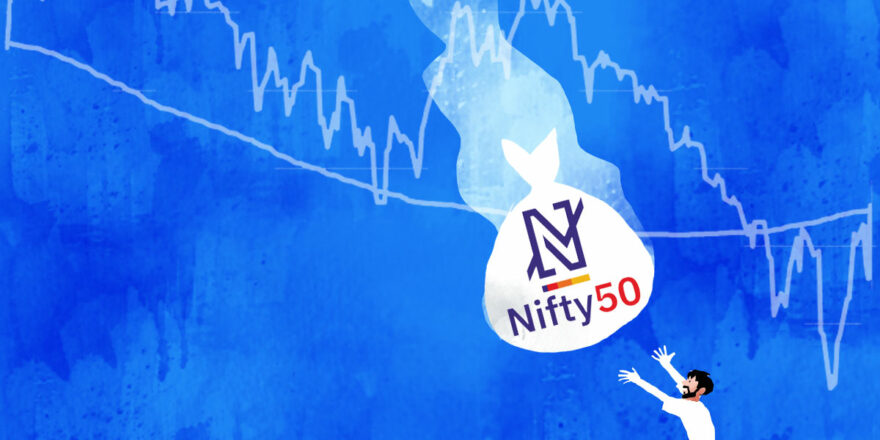Over one-third Nifty50 stocks look weak on charts. Time to be cautious?
The domestic benchmark indices — the S&P BSE Sensex and the National Stock Exchange Nifty50 — had lost close to 1.5 per cent in three days recently before gaining slightly.
Notwithstanding weakness and volatility, the Nifty50 has managed to hold on to the 18,000 mark, while the Sensex has managed to stay above the 61,000 level.
The performance of the stocks that comprise these front-line indices remains polarised.
The 20 stocks that comprise the Nifty50 index appear weak, according to their technical chart patterns.
Sixteen of these stocks, which include Tata Steel, Hindalco Industries, JSW Steel, Eicher Motors, Sun Pharmaceutical Industries, and Cipla, have breached their respective 200-day moving averages (DMA) on the downside.
For long-term investors, the simple 200-DMA provides a broad outlook on the market or stock trend. Investors and traders prefer stocks holding above their respective 200-DMA as they tend to perform better in a trending market.
Risk management, hence, becomes comparatively easier.
Alternatively, Dr Reddy’s Laboratories, Larsen & Toubro, Titan Company, and Grasim Industries appear weak as their relative strength indicator (RSI) has slipped below 50.
The RSI typically oscillates between zero and 100.
A stock or index is considered overbought when RSI is above 70 and oversold when it is below 30.
The contribution from the information technology sector to the markets recently has been nothing to write home about.
Infosys, Wipro, and Tata Consultancy Services have been rangebound with a negative bias.
Shares of Adani Group stocks, such as Adani Enterprises and Adani Ports and Special Economic Zone, too, remain volatile and will continue to be so until they move past their key resistance levels.
Analysts believe the market is likely to remain choppy in the near term, and bears may have the upper hand. The 6 per cent rally in the Nifty from March lows, observes V K Vijayakumar, chief investment strategist at Geojit Financial Services, has been used as a profit-booking opportunity by domestic institutional investors (DIIs) and traders.
This trend, he believes, is evident from the ‘buy the rumour, sell the news’ in major stocks like State Bank of India (SBI) and ITC in spite of good 2022-23 (FY23) January-March quarter (fourth quarter, or Q4) results.
“The Nifty is finding it difficult to break the 18,100–18,400 range despite favourable global cues and good Q4FY23 results.
“The US 10-year bond yield has risen to 3.64, and the rupee has weakened to 82.65 to the dollar.
“This currency movement is not supportive of the equity market. Foreign institutional investor buying is being neutralised by DII selling.
“The ‘sell on rally’ strategy of bears has worked well this week.
“The near-term outlook remains cloudy,” says Vijayakumar.
The Nifty has until now found some support from select fast-moving consumer goods stocks such as ITC, Britannia Industries, and Nestlé India in the past few weeks.
These counters have formed ‘higher highs and higher lows’ in line with their technical chart pattern and are still in bullish mode from a medium-to-long-term perspective.
Among banking majors, Axis Bank, ICICI Bank, HDFC Bank, and SBI appear on track to hit new all-time highs in the weeks ahead, the charts indicate.
Technical analysts suggest that the markets could find some support at lower levels and that the current weakness will eventually get bought into.
“If global markets support us, we may see this decline getting bought into, and this time there may be a genuine attempt to retest the higher levels of 18,240–18,300 on the Nifty.
“On the flip side, 18,100 followed by 18,050 can be considered a strong support zone for the index,” says Sameet Chavan, head-research, technicals, and derivatives, Angel One.
Disclaimer: This article is meant for information purposes only. This article and information do not constitute a distribution, an endorsement, an investment advice, an offer to buy or sell or the solicitation of an offer to buy or sell any securities/schemes or any other financial products/investment products mentioned in this article to influence the opinion or behaviour of the investors/recipients.
Any use of the information/any investment and investment related decisions of the investors/recipients are at their sole discretion and risk. Any advice herein is made on a general basis and does not take into account the specific investment objectives of the specific person or group of persons. Opinions expressed herein are subject to change without notice.
Source: Read Full Article


